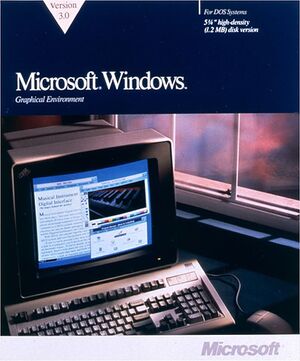Windows 3.0

| |
| Windows 3.0 | |
| Developer | Microsoft |
|---|---|
| Publisher | Microsoft |
| Platforms | x86 |
| Released | 3.0: May 22, 1990 3.0a: December 1990 MPC: October 1991 3.1: April 6, 1992 Workgroups 3.1: October 1992 NT 3.1: July 27, 1993 Workgroups 3.11: August 11, 1993 3.11: November 8, 1993 3.2: November 22, 1993 NT 3.5: September 21, 1994 NT 3.51: May 30, 1995 |
| Added to Museum |
Not yet |
Windows 3.0 is the third iteration of the Windows product line by Microsoft.
Like Windows 1.0 and Windows 2.0, Windows 3.0 was a mouse-controlled graphical user interface that ran inside DOS rather than an operating system itself.
Multimedia PC standard
Windows 3.0 with Multimedia Extensions, released in 1991, was based on Windows 3.0a. It supported sound cards and CD-ROM drives. It was the minimum operating system recommended for Multimedia PCs, and games and applications of the time sometimes listed MPC as the recommended operating system.
Differences from previous versions
Windows 3.0, 3.0a, 3.1, 3.11, and the Simplified Chinese-exclusive Windows 3.2 had 16-bit file access but weren't compatible with the Windows 1 and Windows 2 lines due to the use of protected mode. These versions relied on the DOS operating system for essential functions, and thus in most cases were restricted to the 16-bit architecture of DOS.
These versions of Windows ran DOS programs through a DOS-based Virtual DOS Machine, which was first present in Windows/386 2.10.
Windows for Workgroups
Windows for Workgroups was an extension that used the SMB protocol over NetBIOS, allowing for networking of local computers without a centralized authentication server.
Like the mainline Windows 3, Windows for Workgroups 3.1 had 16-bit file access and relied on the DOS operating system for essential functions.
Windows for Workgroups 3.11 also relied on DOS but had a 32-bit protected mode driver instead of the standard 16-bit driver to allow for 32-bit disk access.
Windows NT
NT development originally began as NT OS/2, for the Intel i860 chip, the latter of which was codenamed "N10" and gave NT its name. This built on the source code for OS/2 which Microsoft co-developed with IBM. However, before release Microsoft switched to the x86 processor and forked the source code, allowing IBM to continue OS/2 development on their own.
Windows NT 3.1, labeled as such to keep up with the Windows numbering system, was the first version of Windows that was a complete 32-bit operating system. 16-bit Windows applications were run through a compatibility layer known as Windows on Windows.
It also had the DOS-based Virtual DOS Machine of the mainline Windows 3. This DOS-based VDM and WoW compatibility layer for backward-compatibility were used in Windows NT 3.1, Windows NT 3.5, and Windows NT 3.51.
Physical 16-bit Windows 3.x games owned by WEC Museum
| Title | Developer | Released | Date Added to the Museum | Notes |
|---|---|---|---|---|
| Myst | Cyan | 1993 | January 2, 2015 | Windows 3.1 and Windows MPC (Multimedia Personal Computer) versions. |
| Tetris Gold | Spectrum Holobyte | 1992 | April 5, 2020 | Contains Super Tetris and Tetris Classic. |
Digital 16-bit Windows 3.x games owned by WEC Museum
| Title | Developer | Released | Date Added to the Museum | Notes |
|---|---|---|---|---|
| Checkers Game | Gregory Thatcher | 1990 | April 26, 2019 | |
| Solitaire | Bogus Software | 1990 | January 27, 2024 |
Digital 16-bit Windows 3.x applications owned by WEC Museum
| Title | Developer | Released | Date Added to the Museum | Notes |
|---|---|---|---|---|
| Klik & Play | Europress Software | 1994 | April 25, 2019 | Klik & Play for Schools version, made freeware for general use in 2006. |